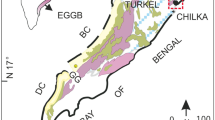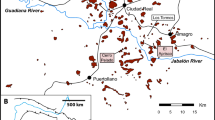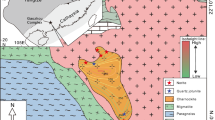Abstract
The garnet megacrysts from Yingfengling basalts are characterized by high FeO (>20%), CaO (7.02% –8.16%) and low MgO (5.88%–10.87%). Significant composition variations are observed in these megacrysts, of which Ni, V, Sc, Co, and HREE are positively correlated with their Mg#, and Zr, Hf, Ga, Y, Sr, Nb, Zn and LREE-MREE are negatively correlated with Mg#. Megacryst parent magma is a highly evolved residual melt with strongl depletion in Ti, Sr, Hf, Nb and HREE. This parental magma was generated by more than 60% of crystallization fractionation of clinopyroxene, garnet, plagioclase and ilmenite from quartz tholeiitic magma. It has not erupted to the surface, but stayed at the upper mantle and formed the megacrystic cumulate. Megacrysts and their host basalt are in disequilibrium.
Similar content being viewed by others
References
Irving, A. J., Frey, F. A., The distribution of trace elements between garnet megacrysts and volcanic liquids of kimberlitic to rhyolitic composition, Geochim. Cosmochim. Acta, 1978, 42: 771.
Upton, B. G. J., Hinton, R. W., Aspen, P. et al., Megacrysts and associated xenoliths: evidence for migration of geochemically enriched melts in the upper mantle beneath Scotland, J. Petrol., 1999, 40: 935.
Bindeman, I. N., Bailey, J. C., Trace elements in anorthite megacrysts from the Kurile Island arc: a window to across-arc geochemical variations in magma compositions, Earth Planet. Sci. Lett, 1999, 169: 209.
Dobosi, G., Jenner, G. A., Petrologic implications of trace element variation in clinopyroxene megacrysts from the Nograd volcanic province, north Hungary: a study by laser ablation microprobeinductively coupled plasma-mass spectrometry, Lithos., 1999, 46: 731.
E. M. -L., Zhao, D. S., Cenozoic Basalts and Deep-seated Xenoliths in Eastern China (in Chinese with English abstract), Beijing: Science Press, 1987, 490.
Chi, J. S., The study of Cenozoic Basalts and Upper Mantle Beneath Eastern China (attachment: kimberlites) (in Chinese with English abstract), Wuhan: China University of Geosciences Press, 1988.
Liu, C. Q., Masuda, A., Xie, G. H., Isotope and trace element geochemistry of alkali basalts and associated megacrysts from the Huangyishan volcano, Kuandian, Liaoning, NE China, Chemical Geology, 1992, 97: 219.
Dong, Z., Pyropes from China: Peridotite xenoliths from kimberlites versus megacrysts in basalts, International Geol. Review, 1997, 39: 141.
Yu, J. H., Fang, Z., Zhou, X. et al., Garnet granulite facies xenoliths from Yingfengling Cenozoic basalt in Leizhou, Guangdong Province, Chinese Science Bulletin, 1998, 43(23): 2013.
Yu, J. H., Luo, S., Megacrysts from Cenozoic Yingfengling basalt in Leizhou Peninsula, South China Mineral Acta (in Chinese with English abstract), 2000, 20(2): 191.
Norman, M. D., Melting and metasomatism in the continental lithosphere: laser ablation ICPMS analysis of minerals in spinel lherzolites from eastern Australia, Contrib. Mineral. Petrol., 1998, 130: 240.
Wood, B. J., Blundy, J. D., A predictive model for rare earth element partioning between clinopyroxene and anhydrous silicate melt, Contrib. Mineral. Petrol., 1997, 129: 166.
Johnson, K. T. M., Experimental determination of partition coefficients for rare earth and high-field-strength elements between clinopyroxene, garnet and basaltic melt at high pressure, Contrib. Mineral. Petrol., 1998, 133: 60.
Zhu, B., Wang, H., Nd-Sr-Pb isotopic and chemical evidence for the volcanism with MORB-OIB source characteristics in the Leiqiong area, China, Geochimica (in Chinese with English abstract), 1989, 18(3): 193.
Liu, C., Xie, G., Masuda, A., Geochemistry of Cenozoic basalts from eastern China--I. Major element and trace element compositions: petrogenesis and characteristics of mantle source, Geochimica (in Chinese with English abstract), 1995, 24(1): 1.
Flower, M. F. J., Zhang, M., Chen, C. Y. et al., Magmatism in the South China Basin 2. Post-spreading Quaternary basalts from Hainan Island, South China, Chemical Geology, 1992, 97: 65.
Kushiro, I., Compositions of partial melts formed in mantle peridotites at high pressures and their relation to those of primitive MORB, Phys. Earth. Planet. Inter., 1998, 107: 103.
Paster, T. P., Schauwecker, D. S., Haskin, L. A., The behavior of some trace elements during solidification of the Skaergaard Layered Series, Geo. Cos. Avta, 1974, 38: 1549.
Author information
Authors and Affiliations
About this article
Cite this article
Yu, J., O’Reilly, S.Y. Almandine megacrysts from Yingfengling Cenozoic basalt in Leizhou Peninsula and their parental magma origin. Chin.Sci.Bull. 46, 1215–1219 (2001). https://doi.org/10.1007/BF02900606
Received:
Issue Date:
DOI: https://doi.org/10.1007/BF02900606




